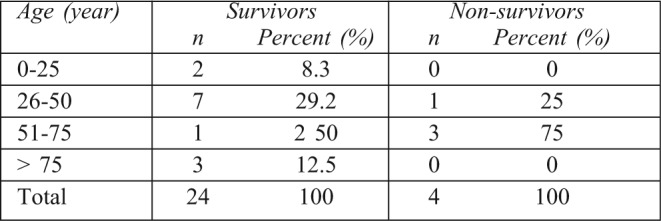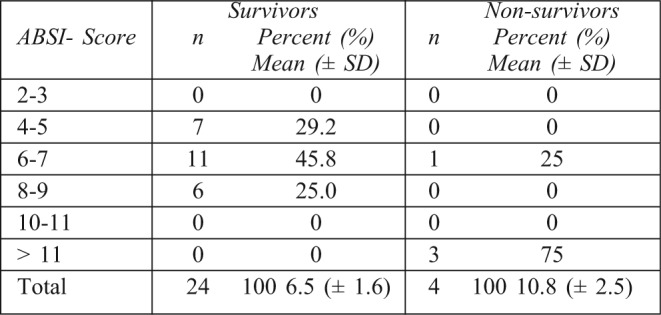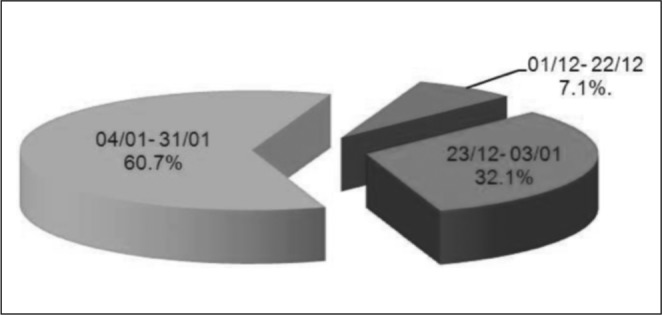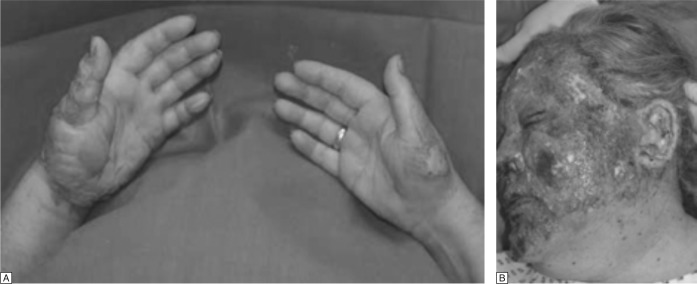Summary
In Switzerland it is customary to light candles on Christmas trees and advent wreaths. This tradition leads to an increased risk of home fires. We reviewed the records of patients who sustained burn injuries from a lit Christmas tree or advent wreath during the Christmas holidays between January 1971 and January 2012. We treated 28 patients and observed 4 fatalities (mortality rate: 14%). 61% of the patients were male, 39% were female. The mean abbreviated burn severity index (ABSI) was 6.5 points in the group of the survivors and 10.8 points in the group of the non-survivors. The mean total body surface area burned (TBSA) for survivors was 18.9%, with 14.1% having full thickness burns; for the non-survivors the mean TBSA was 45.2%, with 38% having full thickness burns. The Mann-Whitney U-test showed a significant difference between the survivors and the fatalities concerning the mean total and full thickness burned body surface area (p value 0.009 and 0.012). More than sixty percent of the fires occurred in January and the most severe accidents were seen after January 4th. Despite Christmas decoration-associated fires being relatively uncommon, they tend to cause more serious injuries than regular household fires. We recommend that in countries where it is customary to set up flammable Christmas decorations, state-issued information pamphlets with instructions on fire safety conduct should be distributed.
Keywords: house fires, christmas tree, burns, mortality, ABSI
Abstract
En Suisse il est de coutume de mettre des bougies allumées sur les arbres de Noël et sur les couronnes de l’Avent. Cette tradition aument le risque d’incendies de maison. Nous avons examiné les dossiers de patients ayant subi des brûlures causées par un arbre de Noël ou une couronne de l’Avent pendant les vacances de Noël entre Janvier 1971 et Janvier 2012. Nous avons traité 28 patients et observé 4 décès (taux de mortalité: 14%). 61% des patients étaient des hommes, 39% étaient des femmes. La moyenne “indice abrégée de gravité de la brûlure” était de 6,5 points dans le groupe des survivants et 10,8 points dans le groupe des décédés. La moyenne de la surface corporelle totale brûlée (SCT) pour les survivants était de 18,9% - avec 14,1% ayant des brûlures au troisième degré; pour les non-survivants la moyenne SCT était de 45,2% - avec 38% ayant des brûlures au troisième degré. Le test U de Mann-Whitney a montré une différence significative entre les survivants et les non-survivants qui concerne la totale moyenne et l’épaisseur total brûlé de la surface du corps (valeur p de 0,009 et 0,012). Plus de 60% des incendies a eu lieu en Janvier et les accidents les plus graves ont été observés après le 4 Janvier. Meme si les incendies associés aux décorations de Noël sont relativement rares, ils ont tendance à causer des blessures plus graves que les incendies domestiques réguliers. Nous recommandons que, dans les pays où il est d’usage de mettre en place des décorations de Noël inflammables, les brochures d’information soient distribués par l’état avec des instructions sur le comportement de sécurité.
Introduction
Fires in many countries have seasonal peaks. While in arid countries fire disasters are more likely to occur in the summer months, in colder climates there is an increased incidence of fires during winter, as heaters and indoor lighting are used more frequently.
The risk of household fires is particularly high during the Christmas period when, in many countries, it is customary to light candles on Christmas trees and advent wreaths. Christmas tree fires have actually been reported to result in more deaths compared to other household fires.1
Annually, about 1,000 home fires are documented in Switzerland during the Christmas holiday season.2 The objective of this study was to investigate epidemiologic features of severe fires around this period leading to hospitalization in the Burn Intensive Care Unit (BICU) in the catchment area of the University Hospital Zurich. A further aim of the study was to analyze the type and severity of sustained injuries in order to develop safety standards for prevention of these particular fire casualties.
Materials and methods
Switzerland has a population of about 8 million3 and Zurich is the largest city with a metropolitan area of 1.4 million inhabitants.4 There are two BICUs in Switzerland: one in Lausanne in the west of Switzerland and one in Zurich. The Department of Plastic Surgery and Hand Surgery at the University Hospital of Zurich provides specialist care for an estimated 5.5 million people from southern Germany and Switzerland, excluding the western part.
The study was approved by the institutional review board. The data of burn patients treated at the specialist BICU between January 1971 and January 2012 were analyzed retrospectively. All patients who required treatment in our BICU following severe burn injuries during the Christmas holidays from a burning Christmas tree or advent wreath were included in the study. Minor burns amenable to outpatient or regular ward treatment were not included.
The variables included sex, age, date of accident, cause of accident, TBSA including the proportion of full thickness burns, type of injury, presence of inhalation trauma, abbreviated burn severity index (ABSI-) score, length of hospital stay and survival.
Records after 2006 were obtained from the computed clinical information system (KISIM, 4.901) at the University Hospital Zurich. All data prior to 2006 were extracted from paper archives.
The characterization of the injury pattern was limited to patients treated from 1998 onward.
Mathematical statistics were performed with the assistance of the Division of Biostatistics at the University of Zurich. Statistical calculations were performed with SPSS for Windows (Vers. 17.0). Descriptive statistics included number, percentage, mean, standard deviation (SD) and median. The mean was used to describe the central tendency for variables that were normally distributed. The median was used for variables not normally distributed. The Mann-Whitney U-test was used to compare metric data. The level of significance was set at 0.05.
Results
During the study period of 41 years (from January 1971 to January 2012), we treated 28 patients in our BICU for burn injuries caused by Christmas decorations. The patient demographics are highlighted in Tables I and (II.
Table I. Sex specific rate of survivors and non-survivors.

Table II. Age specific rate of survivors and non-survivors.

The ABSI score was calculated routinely for each patient as a prognostic indicator. The majority of the patients scored between 6 and 7 points, giving them an estimated probability of survival of 80-90%. The mean ABSI of survivors was lower than that of non-survivors (Table III).
Table III. ABSI-score of survivors and non-survivors.

The median length of hospital stay for all survivors was 18.5 days compared to 7 days for non-survivors.
Stratifying the length of stay by ABSI groups revealed that patients with an ABSI score of 8-9 had longer hospitalization times than patients with an ABSI greater than 11. Patients who survived had significantly less extensive burns both with regards to TBSA and percentage of full thickness burns (Table IV).
Table IV. Mean of total and full thickness burned body surface of survivors and non-survivors.

Christmas trees were the cause of fire in 89% and advent wreaths in 11% of cases.
Due to incomplete records the injury pattern could only be assessed in patients treated from 1998 onward. In these patients, the typical pattern of injury included severe burns of both hands and the face (Figs. 1a and b).
Fig. 1. Typical injury pattern of severe burns caused by the attempt to carry away the burning tree: (a) Superficial burn of the left Palma manus and mixed degree burn of both dorso-radial thumbs; (b) Superficial and full thickness burn injury of the face.
Only 32% of all household accidents occurred during the public Christmas holidays, which typically last from December 23rd to January 3rd. Stratified by months, the majority of the fires occurred from January 4th to the end of January (60.7%), whereas only 7% of cases were observed from the end of January to December 22nd (Fig. 2). No Christmas decoration- associated fires were seen between February and November. Classifying the date of accident as a function of ABSI revealed that more severe accidents happened after the holiday season from January 4th to the end of January. In all four fatalities, the injury occurred in January.
Fig. 2. Month and date of accident of patients treated in the Burn Intensive Care Unit of the University Hospital of Zurich 1971-2012; (n= 28).

The overall mortality rate was 14% (n=4). 75% of these patients were over 50 years old. Half (n=2) of the fatalities had a coexistent inhalation injury. None of the survivors had an inhalation trauma.
Discussion
To our knowledge this is the first analysis of burn injuries during the Christmas season. Despite the periodic occurrence of home fires during the Christmas holidays, we found a paucity of data in the literature concerning this topic.
Al Qattan et al.5 published a review of burns related to traditions, social habits, religious activities, festivals and traditional medical practices. This review was a summary of thermal injuries related to cultural customs from Jewish, Muslim, Indian and Buddhist religions. Gohritz et al.6 responded in form of a letter to the editor reporting on 24 cases of Christmas-related burn injuries requiring intensive care in the form of a letter to the editor.
The National Fire Protection Association (NFPA) in the United States publishes a fact sheet every year with their recorded data.7 In a 4-year period from 2007 to 2011, they observed 230 household fires caused by Christmas trees. These fires lead to 6 civilian deaths each year. We observed 4 deaths in a period of 41 years. This difference can be attributed to the different population sizes and the fact that our data only reflects that of a single center. The Swiss Council for Accident Prevention records an annual incidence of 1,000 fires during the Christmas holiday season, without specifying if these were caused by trees, candles, advent wreaths or other means.2 Another publication reports about 600 fires per year caused by candles, but not especially during the Christmas season.9 To further substantiate our data, we requested a specific analysis from the Association of Public Insurance Companies (APIB). They documented 77 home fires in the last ten years in Switzerland during the Christmas holiday season.10
In our study, 89% of the household fires involved Christmas trees and 11% advent wreaths. In all cases, the fire was induced by candles and no decorative electrical lighting was involved. This is in contrast to the cases reported by the NFPA. According to their data, one third of the Christmas tree fires in the USA were caused by electrical problems and only in 7% by candles.7 This is because in Switzerland candles are more commonly used than decorative electrical lighting. The historical reason for this tradition dates back to the first description of a Christmas tree decorated by candles in 1611, which took place in the duchy of Silesia.11
The cause of accident also explains the differences observed in the time periods of the accidents when comparing the NFPA’s and our data pool. In our study, more than 60 percent of the fires occurred in January and the most severe accidents were seen after January 4th. In contrast, 43% of Christmas decoration associated fires reported in the United States occurred in December7 (Figs. 2 and 3).
Fig. 3. Month of accidents of home structure fires in which Christmas trees were ignited; USA 2007-2011; (n= 230).

Christmas trees are usually cut down for sale in early December and then installed in heated rooms. Over time the trunk and the needles dry out, making them increasingly susceptible to fire as time progresses. Therefore lighting the Christmas tree candles towards the end of the holiday season in early January can ignite the tree very easily. At this late stage, the dryness of the tree causes it not to merely catch fire, but rather leads to an explosion- like flash fire which can set the entire room alight within seconds. Another contributing factor to the injury severity is that persons involved in the accident often have a reduced reaction time due to alcohol consumption. White et al.12 published their results on the flammability of Christmas trees, having tested trees which were dried out with heat lamps. These trees ignited violently and caused a dramatically increased heat release rate of 500 to 650 kW compared to 69 kW for “freshly” cut trees. In many of the tests, flames reached out of the doorway of the room. A study by the Department of Forestry in Canada13 demonstrated the value of keeping the butt of the tree immersed in water. For trees that stand in water, thus maintaining foliar moisture content at 100%, ignition with matches was not possible. Christmas trees with a foliar moisture level below 50% ignited readily from matches and those with a level below 20% burned vigorously. On the homepage of the NFPA there is a video which demonstrates very impressively the flammability of a dry Christmas tree versus a tree that has been watered regularly.14 Moreover, a video of the National Institute of Standards and Technology (NIST) illustrates how within 45-60 seconds the entire room is set alight.15
Similar to our data pool, Erlandsson et al. 16 observed most accidents with the highest proportion of fatalities (13%) in January.
Fires caused by electrical faults, such as frayed wires or defects in the insulation, are more likely to occur upon the first ignition of the lighting. This explains why Christmas tree associated fires in the United States tend to occur earlier in the holiday season.7
The typical injury pattern of burns to the hands and face is most likely caused by the attempt to carry away the burning tree (Figs. 1a and b).
More than half of the patients in our study were aged between 51 and 75 years (53.6%). This result is similar to the patient cohort reported in a letter to the editor by Gohritz.6 In this study, 50% of the patients were over 60 years old, which is supported by Erlandsson et al. who report a predominance of elderly people sustaining burns from candle flames. This further coincides with the fact that older people are more likely to celebrate Christmas with a traditional tree and candles than younger people.
Analysis of our data confirms that the ABSI score is a good predictor of mortality. The mean ABSI in the group of the non-survivors was 10.8 points, which correlates with a mortality of 60-80%.19 Recently, Forster et al.18 showed that despite medical and demographic changes, the ABSI scoring system, described by Tobiasen in 1982,19 remains an accurate tool for predicting mortality in burns patients.
Concerning the mean total and full thickness burned body surface area, the Mann-Whitney U-test showed a significant difference between the survivors and the fatalities. This also confirms that the burned TBSA is also one of the most important parameters comprised in the ABSI score for predicting mortality.18
Surprisingly, although ignition of a Christmas tree or advent wreath usually causes an explosion-like flame development, potentially leading to the emission of toxic gases in a confined space, we observed only two cases of inhalation injury.20 Both of these patients died.
The NFPA reports that on average, one of every 40 reported household Christmas tree fires results in a death, compared to an average of one death per 142 total reported household fires by other causes.7 Despite Christmas decoration- associated fires being relatively uncommon, these data indicate that they tend to cause more serious injuries than regular household fires.
Conclusion
To prevent these holiday fire casualties, it is important to inform the population regularly about the dangers associated with Christmas trees. Current advice to the general population in Switzerland merely recommends placing a bucket filled with water beneath the tree.21 Since the dried trees frequently cause a vast explosion-like ignition, this measure alone is certainly insufficient. During the observed decades there was an undulant course of the incidence of these fires with their peak between the years 2001-2010. This supports the insufficiency of the so far recommended measures. More effective prevention of such disasters may be achieved through advising people to refrain from lighting their Christmas trees after New Year’s Eve (as recommended by the Swiss Fire Information Center) or better still, in our opinion, after December 26th, and informing them of the value of keeping the butt of the tree immersed in water. We would like to emphasize that, in countries where it is customary to set up flammable Christmas decorations, state issued information pamphlets with instructions on fire safety conduct should be distributed with the purchase of advent wreaths and Christmas trees.
References
- 1.Ahrens M. Fire Analysis and Research Division. National Fire Protection Association; USA: 2007. Home christmas tree and holiday light fires. [Google Scholar]
- 2.bfu- Beratungsstelle für Unfallverhütung: In der Schweiz brennt es an Weihnachten rund tausend Mal. [Accessed April 3, 2014]. [http://www.bfu.ch/de/diebfu/kommunikation/medien/im-und-ums-haus/feuer-undhitze/feuer-und-hitze/in-der-schweiz-brennt-es-an-weihnachtenrund-tausend-mal. ]
- 3.Swiss Federal Statistical Office: Population size and population composition, recent monthly and quarterly figures: provisional data. [Accessed March 3, 2013]. [http://www.bfs.admin.ch/bfs/portal/de/index/themen/01/02/blank/key/bevoelkerungsstand/01.html. ]
- 4.Canton of Zurich, Department of Justice and Home Affairs: Population Statistic 2012. [Accessed March 28, 2013]. [http://www.statistik.zh.ch/internet/justiz_inneres/statistik/de/daten/themen/bevoelkerung_soziales/bevoelkerung.html. ]
- 5.Al-Qattan MM, Al-Zahrani K. A review of burns related to traditions, social habits, religious activities, festivals and traditional medical practices. Burns. 2009;35:476–81. doi: 10.1016/j.burns.2008.03.001. [DOI] [PubMed] [Google Scholar]
- 6.Gohritz A, Busche M, Aust M, Vogt PM, Guggenheim M. Burn injuries due to Christian religious customs. Burns. 2010;36:291–2. doi: 10.1016/j.burns.2009.04.026. [DOI] [PubMed] [Google Scholar]
- 7.National Fire Protection Association: Christmas Tree Fact Sheet. [Accessed April 3, 2014]. [http://www.nfpa.org/~/media/Files/Research/Fact%20sheets/ChristmasTreeFactSheet.pdf. ]
- 8.U.S. Department of Commerce: United States Census Bureau. [Accessed March 28, 2013]. [http://www.census.gov/population/www/ popclockus.html. ]
- 9.Feuerwehr Wetzikon Seegräben: Weihnachten. [Accessed July 17, 2013]. [http://www.feuerwehr.ws/pravention/wehnachten/ ]
- 10.Imhof M. Loss statistic. Association of public insurance companies; Bern: 2011. [Google Scholar]
- 11.Cullmann O. „Die Entstehung des Weihnachtsfestes und die Herkunft des Weihnachtsbaumes“, Quell- Verlag. Stuttgart: 1994. [Google Scholar]
- 12.Proceedings of the International Conference on Fire Safety. Columbus; Ohio, USA: 1997. Flammability of Christmas Trees and Other Vegetation. [Google Scholar]
- 13.Van Wagner CE. Flammability of Christmas tree, Department of Forestry Publication No. 1034. Department of Forestry, Forest Research Branch; Ottawa, Canada: 1963. [Google Scholar]
- 14.National Fire Protection Association: Christmas Tree Fires. [Accessed March 28, 2014]. [http://www.nfpa.org/categoryList.asp?categoryID=296&URL=Safety%20Information/For%20consumers/Holidays/Christmas%20tree%20fires. ]
- 15.National Institute of Standards and Technology: Fires Safety for the Holidays. [Accessed June 6, 2013]. [http://fire.nist.gov/tree_fire. htm. ]
- 16.Erlandsson U, Huss F. Highly important during Christmas holidays. Elderly persons are overrepresented when it comes to candle light fires. Lakärtidningen. 2005;102:3897–8. [PubMed] [Google Scholar]
- 17.Peck M. Epidemiology of burns throughout the World. Part II: Intentional burns in adults. Burns. 2012;38:630–7. doi: 10.1016/j.burns.2011.12.028. [DOI] [PubMed] [Google Scholar]
- 18.Forster NA, Zingg M, Haile SR, Kunzi W, Giovanoli P, Guggenheim M. 30 years later-does the BASI need revision? Burns. 2011;37:958–63. doi: 10.1016/j.burns.2011.03.009. [DOI] [PubMed] [Google Scholar]
- 19.Tobiasen J, Hiebert JM, Edlich RF. The abbreviated burn severity index. Ann Emerg Med. 1982;11:260–2. doi: 10.1016/s0196-0644(82)80096-6. [DOI] [PubMed] [Google Scholar]
- 20.Travis TE, Moffatt LT, Jordan MH, Shupp JW. Factors Impacting the Likelihood of Death in Patients with Small TBSA Burns. J Burn Care Res. N2014NNN doi: 10.1097/BCR.0000000000000113. [DOI] [PubMed] [Google Scholar]
- 21.Swiss information center for prevention of fires. [Accessed March 28, 2013]. [http://www.bfbcipi. ch/BFB/media/Shop-Bilder-Drucksachen/091113_BFB_Merkblaetter_d.pdf. ]



